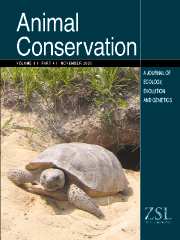Crossref Citations
This article has been cited by the following publications. This list is generated based on data provided by
Crossref.
Ferreras, P.
and
Macdonald, D.W.
1999.
The impact of American mink Mustela vison on water birds in the upper Thames.
Journal of Applied Ecology,
Vol. 36,
Issue. 5,
p.
701.
Rushton, S.P.
Barreto, G.W.
Cormack, R.M.
Macdonald, D.W.
and
Fuller, R.
2000.
Modelling the effects of mink and habitat fragmentation on the water vole.
Journal of Applied Ecology,
Vol. 37,
Issue. 3,
p.
475.
Macdonald, D. W.
Sidorovich, V. E.
Anisomova, E. I.
Sidorovich, N. V.
and
Johnson, P. J.
2002.
The impact of American mink Mustela vison and European mink Mustela lutreola on water voles Arvicola terrestris in Belarus.
Ecography,
Vol. 25,
Issue. 3,
p.
295.
Bonaccorso, Elisa
and
Barreto, Guillermo R.
2002.
Microhabitat use by foraging Venezuelan Wood-Quails (Odontophorus columbianus).
Journal of Field Ornithology,
Vol. 73,
Issue. 3,
p.
318.
Fedriani, Jose
Delibes, Miguel
Ferreras, Pablo
and
Roman, Jacinto
2002.
Local and landscape habitat determinants of water vole distribution in a patchy Mediterranean environment.
Écoscience,
Vol. 9,
Issue. 1,
p.
12.
Bonesi, Laura
Rushton, Steve
and
Macdonald, David
2002.
The combined effect of environmental factors and neighbouring populations on the distribution and abundance ofArvicola terrestris.An approach using rule‐based models.
Oikos,
Vol. 99,
Issue. 2,
p.
220.
Macdonald, David W.
and
Rushton, Stephen
2003.
Modelling space use and dispersal of mammals in real landscapes: a tool for conservation.
Journal of Biogeography,
Vol. 30,
Issue. 4,
p.
607.
MaCdonald, David W.
and
Harrington, Lauren A.
2003.
The American mink: The triumph and tragedy of adaptation out of context.
New Zealand Journal of Zoology,
Vol. 30,
Issue. 4,
p.
421.
Yamaguchi, Nobuyuki
Rushton, Steve
and
Macdonald, David W.
2003.
HABITAT PREFERENCES OF FERAL AMERICAN MINK IN THE UPPER THAMES.
Journal of Mammalogy,
Vol. 84,
Issue. 4,
p.
1356.
GURNELL, J.
LURZ, P. W. W.
SHIRLEY, M. D. F.
CARTMEL, S.
GARSON, P. J.
MAGRIS, L.
and
STEELE, J.
2004.
Monitoring red squirrelsSciurus vulgarisand grey squirrelsSciurus carolinensisin Britain.
Mammal Review,
Vol. 34,
Issue. 1-2,
p.
51.
Bonesi, L.
and
Macdonald, D. W.
2004.
Impact of released Eurasian otters on a population of American mink: a test using an experimental approach.
Oikos,
Vol. 106,
Issue. 1,
p.
9.
Hammershøj, Mette
Thomsen, Erik A.
and
Madsen, Aksel B.
2004.
Diet of free-ranging American mink and European polecat in Denmark.
Acta Theriologica,
Vol. 49,
Issue. 3,
p.
337.
B. Banks, Peter
Norrdahl, Kai
Nordström, Mikael
and
Korpimäki, Erkki
2004.
Dynamic impacts of feral mink predation on vole metapopulations in the outer archipelago of the Baltic Sea.
Oikos,
Vol. 105,
Issue. 1,
p.
79.
Bonesi, Laura
and
Macdonald, David W.
2004.
Evaluation of sign surveys as a way to estimate the relative abundance of American mink (Mustela vison).
Journal of Zoology,
Vol. 262,
Issue. 1,
p.
65.
Hammershøj, Mette
Pertoldi, Cino
Asferg, Tommy
Bach Møller, Thomas
and
Bastian Kristensen, Niels
2005.
Danish free-ranging mink populations consist mainly of farm animals: Evidence from microsatellite and stable isotope analyses.
Journal for Nature Conservation,
Vol. 13,
Issue. 4,
p.
267.
Hammershøj, Mette
Travis, Justin M. J.
and
Stephenson, Catriona M.
2006.
Incorporating evolutionary processes into a spatially‐explicit model: exploring the consequences of mink‐farm closures in Denmark.
Ecography,
Vol. 29,
Issue. 4,
p.
465.
Bonesi, Laura
Strachan, Rob
and
Macdonald, David W.
2006.
Why are there fewer signs of mink in England? Considering multiple hypotheses.
Biological Conservation,
Vol. 130,
Issue. 2,
p.
268.
Bonesi, Laura
Rushton, Steve P.
and
Macdonald, David W.
2007.
Trapping for mink control and water vole survival: Identifying key criteria using a spatially explicit individual based model.
Biological Conservation,
Vol. 136,
Issue. 4,
p.
636.
Sidorovich, Vadim E.
and
Solovej, Irina A.
2007.
The stoatMustela ermineapopulation decline in northern Belarus and its consequences for weaselsMustela nivalis.
New Zealand Journal of Zoology,
Vol. 34,
Issue. 1,
p.
9.
Melero, Y.
Palazón, S.
Revilla, E.
Martelo, J.
and
Gosàlbez, J.
2008.
Space use and habitat preferences of the invasive American mink (Mustela vison) in a Mediterranean area.
European Journal of Wildlife Research,
Vol. 54,
Issue. 4,
p.
609.


